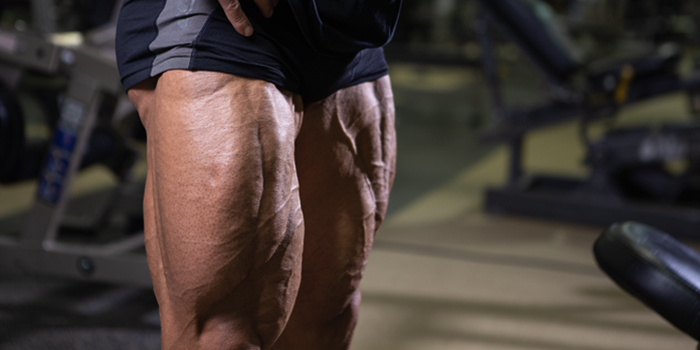
Adversity. If you have air in your lungs, you’ve experienced it. This past year’s been one of the toughest in memory for me personally. The greatest angst came from outside the gym; however, the iron serves as my equalizer. The place in which I go to push myself and experience reprieve from life’s troubles for an hour or so. When nagging injuries prevent me from going full-throttle, research and creativity become vital by forcing me to train smarter so I can also train harder.
Those who follow my training log know my lower back prevents me from training with any appreciable weight on squats. A few low back tweaks while squatting 700 pounds in my early 30s progressively worsened over the years to the point in which direct spine compression completely sidelined traditional squatting. What to do?
This article lays out the foundation in which I continue to stimulate quad development in the absence of big pounds. I hope it’s informative to the lifter who battles similar injuries and is an exhortation to the young and healthy to grow intelligently.
The Science
I’m not a science guy unless it translates into real-world results. The foundation of all my exercise protocols detailed below traces its roots to the 1960s and a Japanese doctor. Dr. Sato developed Kaatsu — Ka, meaning “additional,” and atsu, or “pressure.” Today, the Kaatsu technique is better known as blood flow restriction (BFR) training whereby a band is applied to allow arterial while preventing venous blood flow to the trained muscle. You trade weight for reps because with BFR you’re able to use 25 to 50 percent of the weight you’d normally lift with equal results.
Compelling evidence suggests that venous blood flow restriction dramatically increases muscle growth and strength by increasing growth hormone secretion, reducing myostatin and inducing cell swelling in half the time, utilizing a third of the weight when compared to traditional high-intensity training. The lactic acid buildup regulates protein synthesis, stimulates mTOR signaling, and lowers myostatin gene expression. mTOR tells your cells to grow, and myostatin inhibits growth.
A fascinating article that was recently published, titled Type 1 Muscle Fiber Hypertrophy after Blood Flow-restricted Training in Powerlifters, looked at 19 Norwegian national level powerlifters. In short, they performed four sets of front squats, used 24 percent of their 1-rep max, and took 30-second rest periods between sets, all while restricting blood flow to their quads. The results speak for themselves — 12 percent quad growth in two weeks.
The Tools
The beauty of blood flow restriction training, aside from time savings and utilization of light weights, which reduces the chance of injury, is that all you need is a simple pair of knee wraps. Due to my lower back issues preventing me from performing traditional back squats, I don’t use a lot of tools. Listed below is my complete arsenal of tools:
- Wraps used for restricting blood flow: elitefts Normal Knee Wraps
- Cambered bar to aid spine alignment when squatting: Rackable Cambered Squat Bar
- Dumbbells: Goblets are my go-to back squat alternative.
The Exercises
Listed below are the most dominant foundational exercises in developing massive legs via direct blood flow restriction or techniques that mimic the effect.
Norwegian BFR Cambered Bar Squats
This is the exercise I selected to mirror the BFR study mentioned previously. Front squats tend to mess up my lower back, unlike cambered bar squats. Below lists what I achieved on this particular exercise but check out this training log for the full workout details.
It’s one of the most brutal workouts I’ve done that did not include big pounds. The key is to wrap your upper thigh, take 30-second breaks and perform 4 sets. Set 1 and Set 4 are to failure, although I basically hit failure on all 4 sets.
- Set 1 x failure (23 reps) with 135 pounds
- Set 2 x 15 reps with 135 pounds
- Set 3 x 11 reps with 135 pounds
- Set 4 x failure (9 reps) with 135 pounds
Occluded (BFR) Leg Extensions
This is the most basic quad-focused approach to BFR training. The idea here is to again wrap your upper thigh, use 40 percent of your 1RM, perform sets of 15 reps, rest 30 seconds between sets, and do 4 sets total. The lactic acid buildup is intense.
Here is a video:
Alternating BFR Extensions & Goblet Squats
This is probably my favorite variation. The idea is to perform sets of 8 reps on both leg extensions and heels-elevated goblet squats. Rather than a specific rest period of 30 seconds, simply alternate between each exercise until you’ve done each one 3 times. Take off the wraps and rest 3 minutes before re-applying the wraps and doing another 3 rounds.
Here is a video:
Dr. John Rusin Goblet Squat Challenge
A muscle placed under continuous tension naturally imitates blood flow restriction. That’s why a continuous rep tempo for anything over 15 burns so bad; it’s due to the lactic acid build-up. The Dr. Rusin Challenge is a great addition to any workout, and while I have performed it with wraps, it’s brutal either way. The idea is to use a dumbbell that’s 50 percent of your body weight and get 25 reps.
Here is a video:
Drop and Giant Sets
Drop and giant sets are perfect ways to increase a cell swelling pump via added reps beyond the standard 8 to 12. The high reps with limited rest between the drop or next exercise usher in similar benefits to blood flow restriction training.
Here is a drop set video:
Here is a giant set video:
Goblet Squat Isohold Finisher
As previously mentioned, a contracted muscle naturally restricts blood flow, which explains why isoholds burn so badly. This is an excellent quad finisher with 15 reps of heels-elevated goblet squats bookend with isoholds.
Use a dumbbell that’s 30 percent of your body weight. Start with a 15-second isohold near the mid-point of the squat rep, perform 15 full-range reps, and then finish with another 15-second isohold or as long as you can endure the pain!
Here is a video:
Conclusion
To plainly state it: If you’re not using Kaatsu/blood flow restriction training, you’re missing out on a huge opportunity for growth. In my 20s, I lived for high-intensity training until injuries mounted.
Now that I’m approaching my mid-40s, the hunger for a challenge in the gym hasn’t waned. BFR provides me with the opportunity to push myself but in a much safer manner. Training harder need not be mutually exclusive from training smarter. Start wrapping your upper thigh and enjoy the benefits of both.











I've been pleasantly surprised by the ability of BFR to keep size on my quads and allow the squat-pattern movements back into my program. Hope you experience the same!
All the best,
Mark